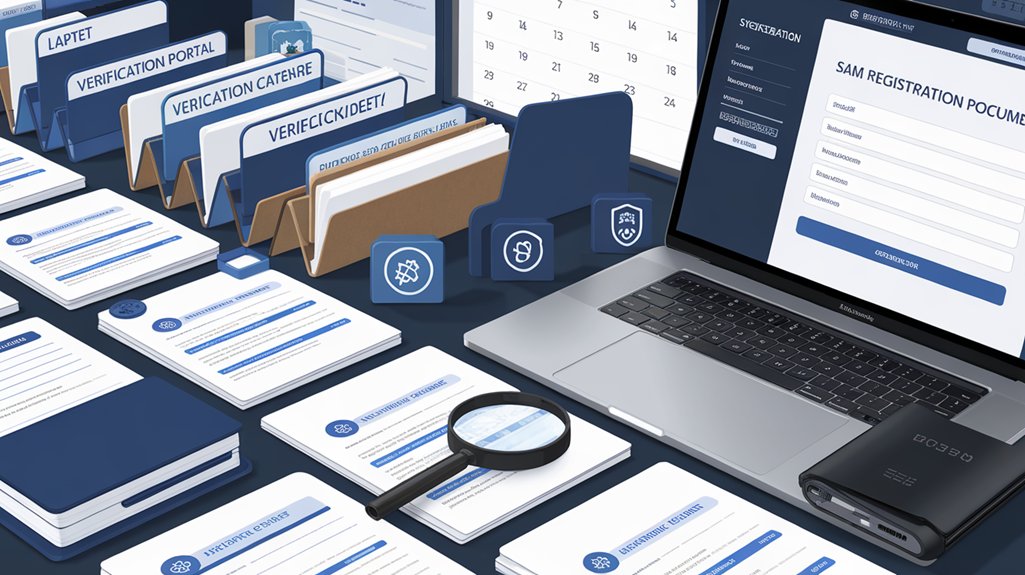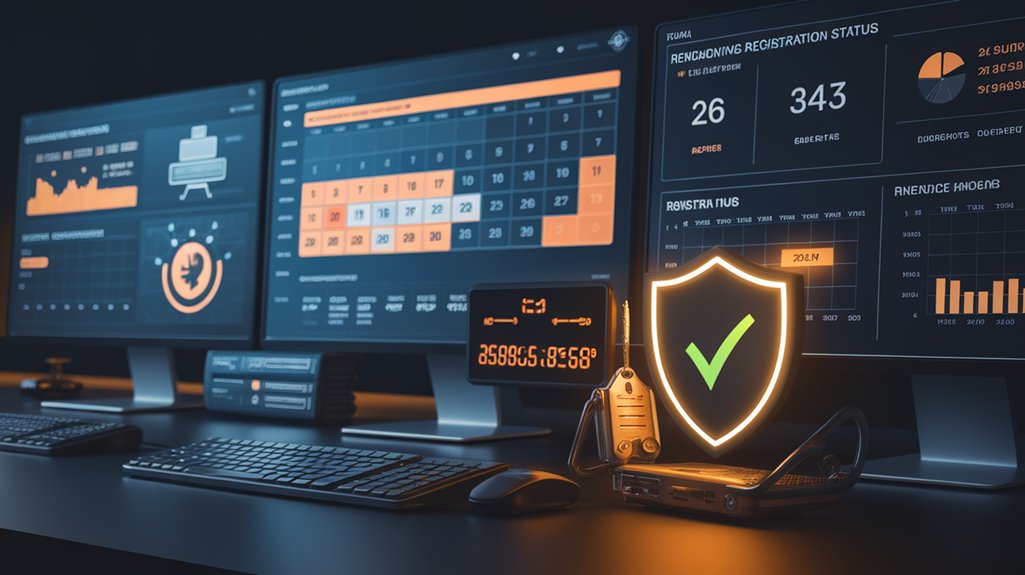To avoid SAM registration lapses, implement a structured renewal timeline beginning 60-90 days before expiration. Set automated reminders at 90, 60, and 30-day intervals, and validate all core entity data including UEI, TIN, legal name, and address against IRS records. Document renewal submissions with screenshots and confirmation emails. Allow 7-14 business days for standard processing, plus additional time for CAGE code verification. Regular quarterly audits of business information guarantee continuous compliance throughout the registration lifecycle.
Table of Contents
ToggleEssential Timeline Strategies for SAM Registration Renewal

Vigilance serves as the cornerstone of effective SAM registration management. Organizations must implement strategic timeline protocols to prevent costly registration lapses that can immediately block access to federal contract opportunities.
Proactive SAM oversight prevents costly lapses that can instantly derail federal contracting access.
A thorough renewal checklist should be initiated 60-90 days before expiration, beginning with validation of core entity data including DUNS numbers and CAGE codes.
Successful registrants establish systematic registration reminders at 90, 60, and 30-day intervals prior to expiration dates. This multi-tiered approach guarantees adequate processing time for the 7-14 business days required for standard renewals, with additional buffer for CAGE code verifications that may add another 10 days to the process. The renewal process is entirely free of charge when completed by the entity themselves, eliminating any financial barriers to maintaining compliance. Maintaining an active SAM status is mandatory for any organization seeking to bid on government contracts or receive federal funding.
Companies should document renewal submission with screenshots and confirmation emails, while simultaneously scheduling the next renewal preparation cycle within eight months of completion to maintain continuous federal contracting eligibility.
Critical Documentation Verification Steps to Prevent Rejection

Meticulous documentation verification stands at the forefront of successful SAM registration maintenance. Organizations must guarantee their Unique Entity ID (UEI) and Taxpayer Identification Number perfectly match IRS records, along with their legal name and physical address. Discrepancies in these critical documentation elements frequently trigger rejections.
Entity administrators should implement systematic verification steps before submission:
- Compare the legal business name character-by-character with IRS records
- Verify physical address consistency across all federal systems
- Confirm NAICS codes appear in proper format and reflect current operations
- Include properly executed notarized letters from authorized officials
- Review banking information for accuracy
The most common rejection factors stem from inconsistencies between SAM data and other federal systems. Organizations should utilize SAM.gov’s validation tools to pre-screen submissions and maintain a regular schedule for reviewing registration status, particularly 60 days before expiration dates. Remember that completing the renewal process can take up to 10 business days, so plan accordingly to prevent registration lapses. Setting calendar reminders for verification is essential to remain active in the SAM system and maintain eligibility for federal contracts and grants.
Proactive Monitoring and Response Protocols for Registration Maintenance

Proactive maintenance of SAM registrations requires systematic monitoring and timely intervention throughout the year. Organizations should implement automated reminder systems that flag upcoming deadlines and configure calendar alerts every three months for profile reviews.
Establishing ownership change protocols guarantees registration accuracy when business structures shift, preventing costly delays in federal contracting opportunities. Regular SAM updates significantly enhance business opportunities and maintain compliance with federal regulations. Implementing regular polling intervals for registration status checks can provide early detection of potential issues before they impact compliance standing. Maintaining accurate banking information is crucial for ensuring proper payment processing and avoiding administrative delays in federal contract awards.
Robust ownership transfer protocols safeguard registration integrity through organizational transitions, ensuring uninterrupted access to federal contracts.
- Quarterly Business Information Audits – Schedule regular reviews of legal business names, addresses, and TINs to verify alignment with IRS records and detect discrepancies before they trigger compliance issues.
- Compliance Oversight Dashboard – Deploy monitoring tools that track SAM.gov exclusion records, synchronize data with compliance dashboards, and flag expiring certifications for renewal.
- Dedicated Role Assignment – Designate primary and backup administrators with clearly defined responsibilities, including regular training on interface navigation and documentation verification procedures.
Consistent vigilance through these protocols maintains valid registration status and prevents unexpected lapses that could jeopardize federal contract eligibility.
Frequently Asked Questions
Can I Transfer My SAM Registration to a New Business Entity?
No, transferring registration between business entities is not permitted in the SAM system.
Each separate business entity must complete its own registration process independently. When establishing a new business entity, the organization must obtain its own Unique Entity ID and complete a new SAM registration.
The legal business name must match across all documentation, and the new entity must satisfy all validation requirements, including IRS verification of the taxpayer identification number.
How Do International Companies Handle SAM Verification Requirements?
International companies navigate SAM verification requirements through several specialized compliance processes.
They must obtain an NCAGE code before registration, submit notarized documentation with certified translations of non-English materials, and provide international TIN equivalents for validation.
Foreign entities must maintain accurate banking information with SWIFT/IBAN details that match their registered name exactly.
Regular monitoring is essential, as international verification processes typically require annual revalidation to maintain active status in the SAM system.
What Happens if My CAGE Code Changes Mid-Registration?
When a CAGE code changes mid-registration, several impacts occur. The registration timeline extends as the system must validate the new code against entity information.
This change triggers additional verification steps by DLA, potentially causing processing delays. Contractors must update all associated documentation, including proposals and contracts, to reflect the new CAGE code.
The system will automatically link the new code to the entity’s UEI, but this synchronization process may take 24-48 hours to complete.
Are There Expedited Renewal Options During Emergency Contracting Situations?
Yes, expedited renewal options are available during emergency contracting situations.
Third-party service providers offer accelerated SAM registration renewal processes specifically designed for urgent scenarios. These services help contractors maintain continuous eligibility when facing time-sensitive federal procurement opportunities.
The expedited renewal guarantees businesses can participate in emergency contracts without registration delays. Organizations can utilize these services to prevent lapses that would otherwise disqualify them from critical government opportunities during emergencies.
How Do Subcontractors Navigate SAM Requirements Versus Prime Contractors?
Subcontractors face fewer SAM requirements than prime contractors in federal contracting.
While prime contractor obligations include mandatory SAM registration and responsibility for verifying subcontractor eligibility, subcontractor responsibilities vary by contract type and program.
Primes must guarantee flow-down clauses from federal regulations reach their subcontractors, who must comply with these terms even without direct SAM registration.
For subcontractors, SAM registration remains strategic rather than universally required, though it can provide competitive advantages when seeking partnerships.